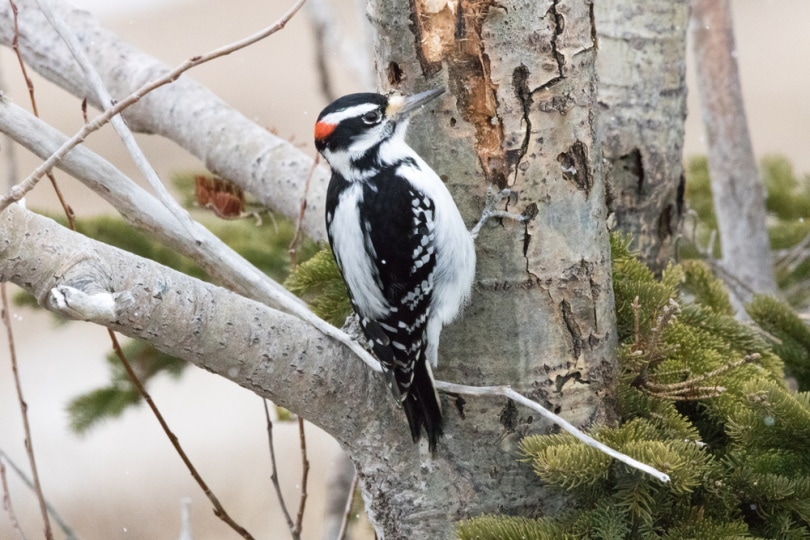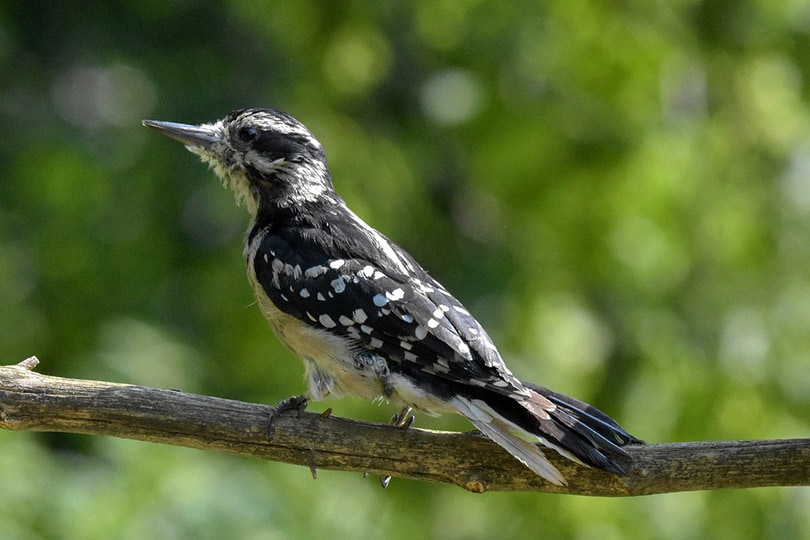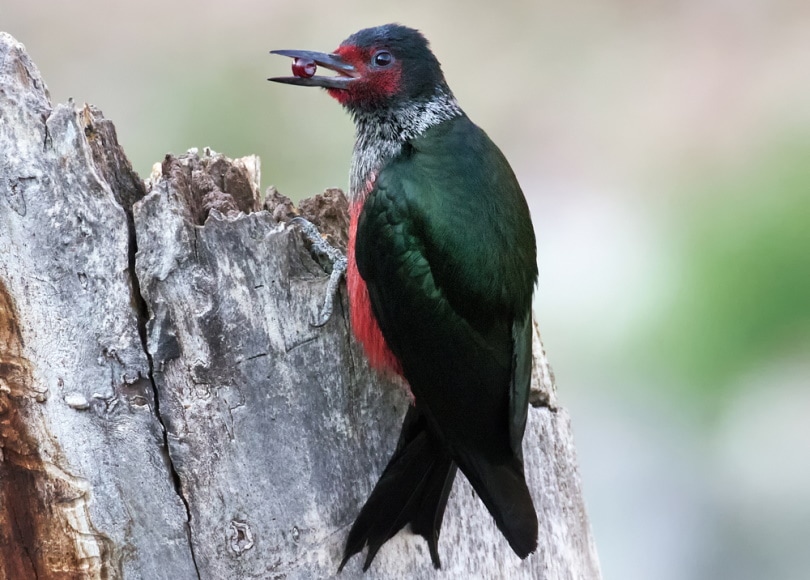10 Species of Woodpeckers In Utah (with Pictures)
Last Updated on

If you love to spot birds around your yard or while spending time outdoors, you probably want to know exactly which species you can find in the area. Birdwatchers and casual nature lovers alike can enjoy learning about the woodpeckers in Utah as these unique birds display behaviors that most other birds do not.
While there are around 300 species of woodpeckers found throughout the world, there are only ten that make an appearance in Utah. Some of these species live in the state throughout the year, but others just pass through for a short time. We’ve put together this detailed list to help you identify and learn more about the various woodpeckers that live in or visit Utah.

The 10 Species Of Woodpeckers In Utah
1. Northern Flicker

| Length | 11–14 inches |
| Weight | 3–6 ounces |
| Wingspan | 17–21 inches |
The northern flicker is sometimes called the common flicker. These birds are mostly neutral-colored with brown feathers and black spots, but they have red coloring on the undersides of their tails and wings. They live throughout theUnited States and are a year-round staple in Utah.
If you’re just getting into bird watching, they are a good species to study as they often hang around residential areas and bird feeders.
2. Downy Woodpecker

| Length | 5.5–6.7 inches |
| Weight | 0.7–1.0 ounces |
| Wingspan | 9.8–12 inches |
There is something charming about the downy woodpecker as they are the smallest woodpecker species in North America. They also live in Utah year-round.
If you have bird feeders, they may come around if you include ingredients such as sunflower seeds and peanuts. Because they do not leave the state during the winter, it’s possible to see them even when the weather’s cold. These birds commonly nest on dead branches or trees.
3. Red-Naped Sapsucker

| Length | 7.5–8.3 inches |
| Weight | 1.1–2.3 ounces |
| Wingspan | 16–17 inces |
It’s difficult to forget this woodpecker, given its unique name.. Red-naped sapsuckers are black and white with red heads and throats. Their chin color depends on their gender as males have red ones and females have white ones.
While the red-naped sapsucker is often seen in Utah, it migrates south to Mexico and Central America during the wintertime. In the warmer months, they are are often found in willow trees in the mountainous areas or near residential homes.
4. Hairy Woodpecker

| Length | 7–10.2 inches |
| Weight | 1.4–3.4 ounces |
| Wingspan | 13–16.1 inches |
The hairy woodpecker is closely related to the downy woodpecker and is found in most of North America throughout the year. It looks similar to a downy woodpecker and has black and white wings with some white feather patterns on tits back. The primary difference between the two is that the hairy woodpecker is larger and has a bigger beak. Generally, hairy woodpeckers eat various insects and often live around large tree trunks.
5. Ladder-Backed Woodpecker

| Length | 6.3–7.1 inches |
| Weight | 0.7–1.7 ounces |
| Wingspan | 13 inches |
Ladder-backed woodpeckers are harder to find because they only live around the Southwestern part of Utah. They sometimes are called “cactus woodpeckers” because they prefer desert areas and scrublands. Their breeding season is between January and March, so these months are your best times to get a glimpse of thewoodpeckers. You’re more likely to see them in shrubs and thickets than flying around tall trees.
They have a black and white “ladder” pattern of stripes on their backs. The males have a red crown, and the females have a black one.
6. Acorn Woodpecker

| Length | 7.5–9.1 inches |
| Weight | 2.3–3.2 ounces |
| Wingspan | 13.8–16.9 inches |
While the coloring of acorn woodpeckers isn’t that much different from other Utah woodpeckers, they have very noticeable eyes that are wide and seem to stick out far from their heads. Their bodies are black, and their bellies, throats, and foreheads are white.
Another way to identify the acorn woodpeckers is by their odd “laugh.” They love to eat acorns and store them inside trees as they are also a very social species. They are present year-round in Utah and prefer nesting in oak trees.
7. American Three-Toed Woodpecker

| Length | 8.3–9.1 inches |
| Weight | 1.6–2.4 ounces |
| Wingspan | 14.6–15.3 inches |
American three-toed woodpeckers are an exciting species to observe because they only live in the Northwest. They live primarily in forest areas in the central part of the state. Their faces are mostly black, but the males have yellow foreheads.
These woodpeckers particularly love burned and damaged forests where they can easily access bark beetles. One interesting fact about this species is that they get their name because they have three toes, while most woodpeckers have four.
8. Williamson’s Sapsucker

| Length | 8.3–9.8 inches |
| Weight | 1.6–1.9 ounces |
| Wingspan | 17 inches |
Utah is one of the only states that William’s sapsuckers call home. They live in coniferous trees and mostly eat sap. Your best chance of seeing one is during the warmer months when they’re looking for mates.
Another characteristic of William’s sapsuckers, which is seem in other species, is that the male and females of the species look very different. The males are mostly black with a red chin and yellow bell, while the females have pale yellow chests and brown heads.
9. Lewis’s Woodpecker

| Length | 10.2–11 inches |
| Weight | 3.1–5 ounces |
| Wingspan | 19.3–20.5 inches |
Lewis’s woodpeckers usually live in pine forests but occasionally come around bird feeders. This species has stunning coloring with pink bellies, gray collars, and green beaks. If you spot one in Utah, count yourself lucky, as they only migrate through the area.
Unlike other species in the family, Lewis’s woodpeckers tend to catch insects in the air instead of using their beaks to dig into trees. They store various nuts in the tree crevices and holes to stock up for wintertime.
10. Yellow-Bellied Sapsucker

| Length | 7.5–8.3 inches |
| Weight | 1.2–2.2 ounces |
| Wingspan | 13.4–15.8 inches |
Yellow-bellied sapsuckers mostly dig up sap as a primary source of food. Their bellies are yellow with bright red crowns, and they aremore colorful than other woodpeckers. . However, they don’t live year-round in Utah but migrate south from Canada. You’re most likely to see them in the winter. Along with their coloration, you can also identify them by the loud calls they make.

Conclusion
If you spend much time in the great outdoors around Utah, keep your eyes peeled for woodpeckers and other bird species. However, you may also see some of these birds around your yard or neighborhood.
There are several ways to attract woodpeckers, such as putting out bird feeders, leaving dead trees on the property, setting up nest boxes, and installing a birdbath. These methods can attract woodpeckers and other common birds to your property.
Featured Image Credit By S. McGrath, Shutterstock
About the Author Robert Sparks
Robert’s obsession with all things optical started early in life, when his optician father would bring home prototypes for Robert to play with. Nowadays, Robert is dedicated to helping others find the right optics for their needs. His hobbies include astronomy, astrophysics, and model building. Originally from Newark, NJ, he resides in Santa Fe, New Mexico, where the nighttime skies are filled with glittering stars.
Related Articles:
Monocular vs Telescope: Differences Explained (With Pictures)
How to Choose Binoculars for Bird Watching: 10 Expert Tips
10 Types of Hummingbirds in Arkansas (With Pictures)
8 Types of Hummingbirds in Nebraska (With Pictures)
5 Types of Hummingbirds in Idaho (With Pictures)
3 Types of Hummingbirds in Mississippi (With Pictures)
8 Types of Hummingbirds in Kansas (With Pictures)
5 Types of Hummingbirds in West Virginia (With Pictures)
